Declarative SentenceA declarative sentence is one that conveys any kind of statement, from crucial information to small details. Declarative sentences, in contrast to interrogative phrases, exclamatory sentences, and imperative sentences, are the most prevalent kind of sentences in the English language because they are the easiest way to transmit information. 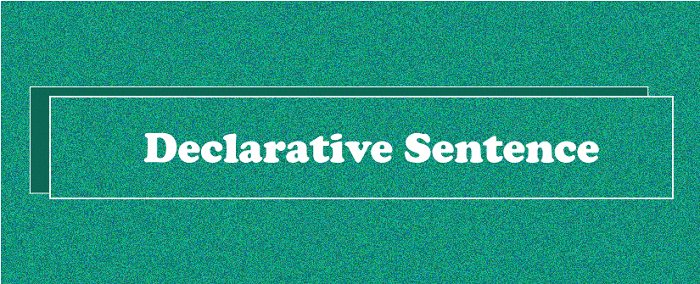
So, how do declarative statements function? Below, we clarify all of the rules and provide expert advice, as well as several declarative sentence samples. What Exactly Is a Declarative Sentence?A declarative sentence, like interrogative sentences, exclamatory phrases, and imperative sentences, is one of 4 sentence kinds in the English language. Each one offers a certain purpose; in declarative phrases, their purpose is to express information immediately. 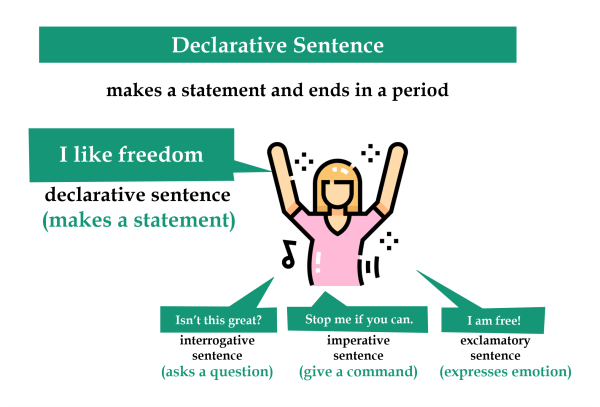
A declarative phrase or a sentence is used whenever you convey a fact, perspective, observation, or explanation in a straightforward manner. For instance, every statement in this paragraph, the paragraph above it, and the paragraph after it are all declarative statements. Declarative sentences, like the majority of sentence kinds, need a subject and a predicate. The subject of a sentence is the noun that does the action, whereas the predicate is merely the verb, or activity, of the phrase. A subject and a predicate combine to create an independent clause, which is required for most sentence types, including declarative statements. Declarative sentences, amongst other common forms of sentences, always conclude with a period. 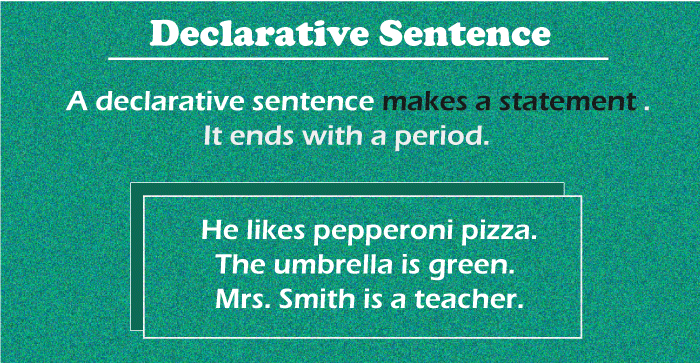
Declarative Sentence Types and ExamplesAs previously stated, each declarative sentence necessitates the inclusion of one independent clause with a subject and a predicate. On the other hand, declarative sentences can comprise more than one independent clause or an independent clause paired with something known as a subordinate clause (often known as a dependent clause). Declarative sentences are classified into four types based on the number of clauses and their characteristics. We've included a basic overview below, but if you want to learn more, see our sentence structure tutorial. Simple Sentence: A simple sentence is one that contains one independent clause and nothing else. Here are some examples of the same ;
Compound Sentence: A compound sentence is one that contains two or more independent clauses. A coordinating conjunction generally links the phrases (for, and, nor, but, or, yet, and so, also known as the FANBOYS), which usually, but not necessarily requires a comma. One can also use a semicolon to join separate sentences.
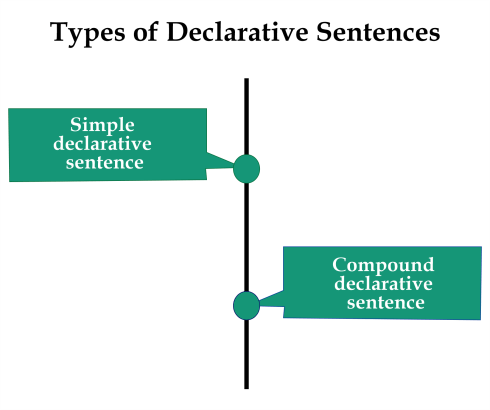
Complex Sentence: A complex sentence is one that contains one independent clause and any quantity of subordinate clauses. Utilize commas if the subordinate clause appears prior independent clause. If not, no comma is required. If I wear my spectacles, the clouds look clear. A compound-complex sentence is one that contains two or more independent clauses and one or more subordinate clauses. They adhere to the criteria for both compound and complex sentences. If I wear my spectacles, the sky looks clear, and the clouds look translucent. The sequence of words in declarative sentences In declarative phrases, the word order is simple and clear: Subject -> Verb -> Objects The subject should appear first, accompanied by the verb (the predicate), and then the indirect and direct objects. Because many sentences lack objects, you may simply require a subject and a predicate. Other sentence components, like as prepositional phrases and the aforementioned subordinate clauses, can be included at the start or conclusion of the sentence. You can also use transition words prior to the subject to assist link sentences in longer works such as creative writing or research reports. What Is the Distinction Between Declarative And Interrogative Sentences?Interrogative sentences are queries, whereas declarative sentences are statements. They fulfill a distinct set of rules in English than declarative statements. Firstly, interrogative statements are followed by a question mark. Secondly, for interrogative statements, the word order is as follows: Verb -> Subject -> Object Consider some examples. Let's start with a basic declarative sentence: The pronunciation of the U.s.a. differs from that of the U.k. Let's restate that as a question or an interrogative sentence. Take note of the differences in word order at the start and punctuation at the conclusion. Is American pronunciation distinct from British pronunciation? What Is The Distinction Between Declarative And Exclamatory Sentences?Declarative sentences and exclamatory sentences are remarkably similar. Although they use the same word sequence, exclamatory sentences conclude with an exclamation point rather than a period. However, despite their appearance, they have quite distinct meanings. Exclamatory sentences provide a sense of urgency, intensity, or surprise. They are used to highlight specific sentences as more intriguing. To demonstrate what we mean, consider rewriting our declarative sentence above into an exclamatory sentence. The pronunciation of the U.s.a. differs from that of the U.k.! The only technical variation is the punctuation at the conclusion, and the word order is similar. The connotation, however, is somewhat distinct. As an exclamatory statement, this instance could indicate that the speaker is ecstatic since they just found the distinction in pronunciation, or it could indicate that they are frustrated since they are unable to comprehend a Scottish soap drama. What Is the Distinction Between Declarative And Imperative Sentences?Finally, imperative statements function similarly to instructions or requests. In other terms, they are employed to issue orders, whether gently or not. The only common sort of sentence that does not require a subject is the imperative sentence. Since imperative sentences are indeed commands, it is presumed that the subject is the person to whom the speaker is speaking. It is not necessary to encompass the subject in the phrase because it is presumed. Imperative sentences usually begin with a verb, although they can alternatively begin with subordinate clauses or a gentle modifier such as "please." They could either finish with a period or an exclamation mark. Change your accent when visiting the U.k. Please use alternative pronunciations of words! A Declarative Statement Serves What Purpose?A declarative sentence's regular function (task) is to make a statement. It informs us or communicates us something (as opposed to a question that inquires us about something or asks for the information). Consider the following examples:
Provide Specifics and Facts With DeclarativesWe now know that declarative sentences begin with a statement that merely provides facts or an opinion and end with a period. They tell the audience exactly what is going on. Declarative sentences are the most prevalent and can be found in all types of writing, from creative to business. A declarative statement is used when you need to get the facts across quickly. Different Sentences for Various PurposesDeclarative sentences are the foundation of communication and writing. To ask a question, give a command, or exclaim, use different kinds of sentences: interrogative, imperative, or exclamatory. The following examples demonstrate the distinction: Interrogative sentences are questions used to elicit information. They conclude with a question mark. Question: Did he eat a meal ? Declarative: He finished his meal. Imperative sentences may end with a period or an exclamation mark. They are utilized to convey instructions or requests. Imperative: Take a seat. Declarative: She takes her seat. Although exclamatory sentences contain the same words as declarative statements, the punctuation is distinctive. The exclamation point adds emphasis to the sentence. Exclamatory: I'm exhausted ! Declarative: I am exhausted. 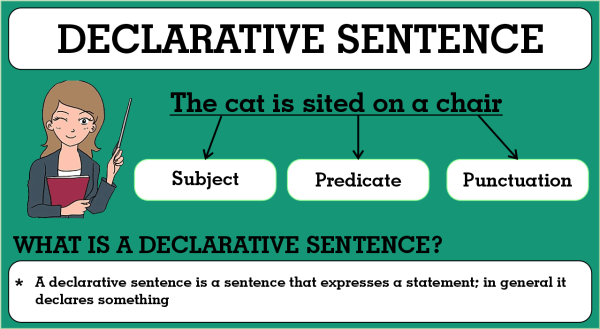
A Declarative Sentence's Word OrderA simple declarative statement's word order is usually subject-verb-object-place-time. As an example : The chicks eat the veggies in the yard in the wee hours. Subject: The chicks Verb: eat Direct Object: veggies Location: in the yard Time: in the wee hours This is not a hard and fast rule. If all writing comprised of simple sentences that followed the same word order, it would be tedious. A complex sentence is as follows: Right before the sun shines, the chicks eat the veggies in the yard. (This is a complex sentence, meaning it contains a primary clause and a subordinate clause.) As you can see, the chronology of the words is distinct (specifically, the time appears first). However, you will realize that the subject-verb word order is preserved in both clauses ("the sun shines" and "the chicks eat"). This is a distinguishing feature of the declarative-sentence structure. In contrast, the order of the words in an interrogative sentence (i.e., a question) is normally transitioned to verb-subject. This is also a strong feature of an interrogative sentence. Consider the following two examples: Katie is from Ireland. (This is a declarative sentence.) Subject-verb agreement is used.) Is Katie of Irish descent ? (This is a question sentence.) The word order is subject-verb.) Consider the following example: She inquired as to whether I adored her gown. (The word order is subject-verb in "whether I adored her gown") ("I"-"adored"). This demonstrates that it is not a question. In fact, it is indirectly a query) Declarative sentences are the most prevalent sort of sentence by far. As a result, if you are studying or teaching English, it is worthwhile to learn the way they are organized. Why Are Declarative Sentences Crucial, And What Are The Main IssuesThere are two typical writing challenges with declarative statements among fluent English speakers. (Issue 1) Never use a question mark in front of a declarative sentence (even if it seems like a query). The most prevalent declarative sentence error is putting a question mark at the conclusion of a statement that isn't a question. The manager has questioned when the celebration begins? - Incorrect I doubt if I can attain it? Incorrect Peter desires to know whether he was chosen. "The supervisor has inquired..." (subject-verb) "I doubt..." (subject-verb) "Peter desires..." (subject-verb) These are unambiguously declarative sentences, not queries (i.e., interrogative statements). Even in the indirect-question parts of the phrases, the word order remains subject-verb: "the celebration begins" (subject-verb) "I can attain it" (subject-verb) "He was chosen" (subject-verb) (Issue 2) In an indirect inquiry, pay attention to the word order. This point is related to Issue 1. Consider that in an indirect query, the wording is exactly the same as in a declarative sentence. As an example: Question Word Sequence:Where is john? (The verb-subject question word order is a verb (is) then subject (john).) Statement Word Order: He is there. (The sentence word order is subject-verb: subject (he) followed by a verb (is).) Word Order for Indirect Questions:I'd like to know where she is. - This is correct (The word order is subject-verb: subject (she) followed by a verb (is), as in a declarative sentence.) Consider the sequence of the wording. I'd like to know where is she? - This is incorrect (Using question word order in an indirect question is incorrect.) (Moreover, these are not inquiries. There should be no question marks.) Declarative Sentences InstancesThe following are some declarative sentence examples, ranging from simple to sophisticated. As you can see, all declaratives are informational assertions that end in a full stop. They can also convey their thoughts. Here are some of examples of declarative sentences;
Next TopicDeclarative Sentence Example
|
 For Videos Join Our Youtube Channel: Join Now
For Videos Join Our Youtube Channel: Join Now
Feedback
- Send your Feedback to [email protected]
Help Others, Please Share









